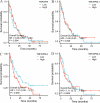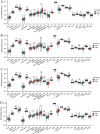Expression patterns, prognostic significance, and immune correlations of the TNFAIP8 family in acute myeloid leukemia: a comprehensive bioinformatics analysis
- PMID: 40335819
- PMCID: PMC12058638
- DOI: 10.1007/s12672-025-02511-5
Expression patterns, prognostic significance, and immune correlations of the TNFAIP8 family in acute myeloid leukemia: a comprehensive bioinformatics analysis
Abstract
Background: Acute myeloid leukemia (AML) is a highly aggressive hematologic malignancy with poor prognosis and high relapse rates. While the TNFAIP8 gene family (TNFAIP8, TNFAIP8L1, TNFAIP8L2, and TNFAIP8L3) is implicated in cancer and immune regulation, its role in AML remains unclear. This study utilized bioinformatics analyses to investigate their expression, prognostic significance, genetic alterations, and immune associations in AML.
Methods: The expression levels and clinical significance of TNFAIP8 family genes in AML were evaluated using UCSC XENA databases. Kaplan-Meier survival analysis was performed to assess overall survival (OS) differences, and receiver operating characteristic (ROC) curves were utilized to evaluate the prognostic predictive abilities of these genes. Genetic alterations were analyzed using the cBioPortal platform, while immune infiltration was examined through ssGSEA and Spearman correlation analysis. Functional enrichment analysis of co-expressed genes was conducted using the KEGG and GO databases.
Results: TNFAIP8, TNFAIP8L1, TNFAIP8L2, and TNFAIP8L3 were significantly overexpressed in AML tissues compared to normal tissues (P < 0.001). However, Kaplan-Meier survival analysis revealed no significant association between their expression levels and OS in AML patients. ROC curve analysis showed that TNFAIP8L2 had the highest predictive accuracy (AUC = 1.000) among the family members, followed by TNFAIP8L1 (AUC = 0.728), TNFAIP8 (AUC = 0.709), and TNFAIP8L3 (AUC = 0.629). Clinicopathological analysis indicated that TNFAIP8 and TNFAIP8L1 expressions were associated with poor cytogenetic risk, while TNFAIP8L3 expression correlated strongly with elevated bone marrow blasts (P < 0.001). Mutation analysis revealed a low frequency of genetic alterations, with TNFAIP8L1 being the only gene with mutations in 0.53% of cases. Immune infiltration analysis demonstrated that TNFAIP8 and TNFAIP8L3 were positively correlated with myeloid-derived suppressor cells (MDSCs), while TNFAIP8L1 expression was associated with natural killer (NK) cell enrichment.
Conclusion: TNFAIP8 family genes play distinct roles in AML pathogenesis and immune regulation. TNFAIP8L2 shows promise as a prognostic biomarker, while TNFAIP8 and TNFAIP8L1 may indicate adverse cytogenetic risk. The study highlights their potential as therapeutic targets in AML.
Keywords: Acute Myeloid Leukemia (AML); Biomarkers; Functional Analysis; Receiver Operating Characteristic (ROC) Analysis; Survival Analysis; TNFAIP8 Family.
© 2025. The Author(s).
Conflict of interest statement
Declarations. Ethics approval and consent to participate: The datasets utilized in this study are accessible through public repositories. The datasets employed in this study are available through public repositories. Consent for publication: Not applicable. Competing interests: The authors declare no competing interests.
Figures









Similar articles
-
Comprehensive analysis of the prognostic and immunological signature of TNFAIP8 family genes in human glioma.Sci Rep. 2024 Aug 2;14(1):17875. doi: 10.1038/s41598-024-68784-y. Sci Rep. 2024. PMID: 39090168 Free PMC article.
-
Identification and validation of BATF as a prognostic biomarker and regulator of immune cell infiltration in acute myeloid leukemia.Front Immunol. 2025 Jan 13;15:1429855. doi: 10.3389/fimmu.2024.1429855. eCollection 2024. Front Immunol. 2025. PMID: 39872530 Free PMC article.
-
Cuproptosis-Related Genes MTF1 and LIPT1 as Novel Prognostic Biomarker in Acute Myeloid Leukemia.Biochem Genet. 2024 Apr;62(2):1136-1159. doi: 10.1007/s10528-023-10473-y. Epub 2023 Aug 10. Biochem Genet. 2024. PMID: 37561332
-
Regulatory Roles of Tumor Necrosis Factor-α-Induced Protein 8 Like-Protein 2 in Inflammation, Immunity and Cancers: A Review.Cancer Manag Res. 2020 Dec 14;12:12735-12746. doi: 10.2147/CMAR.S283877. eCollection 2020. Cancer Manag Res. 2020. PMID: 33364825 Free PMC article. Review.
-
Novel tumor necrosis factor-α induced protein eight (TNFAIP8/TIPE) family: Functions and downstream targets involved in cancer progression.Cancer Lett. 2018 Sep 28;432:260-271. doi: 10.1016/j.canlet.2018.06.017. Epub 2018 Jun 18. Cancer Lett. 2018. PMID: 29920292 Review.
References
-
- Bazinet A, Kantarjian HM. Moving toward individualized target-based therapies in acute myeloid leukemia. Ann Oncol. 2023;34(2):141–51. - PubMed
LinkOut - more resources
Full Text Sources
